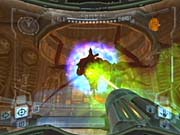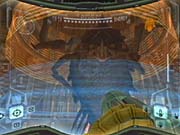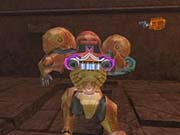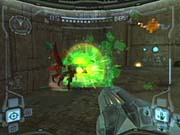Metroid Prime Preview
After eight years, the next installment in the Metroid franchise is coming to the GameCube. Read our hands-on report to find out what to expect from this highly anticipated first-person adventure game.
It's been eight years since the last Metroid game was released. When it was announced that the upstart development house Retro Studios would be creating Metroid Prime, the news was met with trepidation from fans of the franchise. When Nintendo later revealed that the game would make use of the first-person perspective, more negative sentiment concerning the series' future arose. After some minor restructuring, Retro Studios looks like it might prove everyone wrong by delivering a game that contains key ingredients of the Metroid recipe while pushing the boundaries of first-person gameplay.

Metroid Prime was first thought to be a prequel to the entire franchise, but it was recently announced that it will instead be a sequel to Super Metroid. Taking place several years after Samus destroyed Mother Brain and the planet Zebes in said game, Metroid Prime has the famous bounty hunter investigating yet another disturbance caused by the same space pirates that have given her trouble in the past. This time, she's been summoned to Tallon IV, a dangerous and mysterious planet. As Samus enters the planet's orbit, she discovers a seemingly abandoned ship floating in space. She quickly lands her ship on its dock and proceeds to investigate.
Nintendo has been pushing Metroid Prime as a first-person adventure game and trying to steer the press away from calling it a shooter. But in reality, it predominantly plays from a first-person perspective, and there's plenty of gunplay. Like the old saying goes, if it looks like a duck and sounds like a duck, then it must be a duck. But stereotyping Metroid Prime in this manner would be a big mistake, because playing the game is only reminiscent of the typical shooter experience. This is thanks, in large part, to a control scheme that's entirely different from most FPS schemes and the option to transform Samus into her morph ball at any time.
When it was first announced that Samus could transform into her circular alter ego, many thought that it would be merely a novelty at best. Initial footage released of the game seemed to back this up, as it showed Samus transforming and then bomb-jumping up into a tunnel, rolling through the tunnel, and then popping out the other side. But the playable build of the game at the recent E3 quickly dispelled any talk of the feature as a novelty. Samus' morph ball form is essential to solving many of the puzzles in the game, and you'll be asked to perform a variety of attacks and maneuvers while in it. When considering Samus' morph ball, the most important thing to remember is that she's faster and better protected while in its form. If things get too hectic, you can simply press the X button, morph into the ball, and roll away from danger. The morph ball also allows Samus to navigate areas that she could not fit into when in her human form. In one section of the first level, she comes upon a pile of debris blocking her path. After she opens a small crawl space in the debris with her blaster, she can morph into the ball and roll through. Samus can also drop bombs while in her ball form and use them to perform her bomb jump to reach new heights. Additionally, video footage shown at Nintendo's booth depicted Samus rolling through a canyon as if it were a skateboarding half-pipe, and one can only wonder what other sort of uses there might be for Samus' alternate form.

While rolling around as the morph ball is quite a bit of fun, the majority of the game is played from behind Samus' visor. As such, you can see the junction of the helmet and the visor, as well as a number of gameplay essentials on a heads-up display. Gauges for health and ammo, a 3D map, a radar, and lists of selectable weapons or visors are merely a glance away. Two different visors have been shown so far--the combat and scanning visors. The combat visor is the most common and includes all the previously listed features. The scanning visor is used to ascertain information concerning creatures or objects and can also be used to crack codes and unlock doors. To do so, you lock on to the object in question and then hold the L button until a small meter reaches its hilt. Nintendo has stated that there will be two more visors included in the final game, though it hasn't offered any clues as to what they might be. However, some released footage shows a visor that magnifies objects. Swapping visors is as simple as tapping the directional pad.
Through the Eyes of Samus
Metroid Prime wouldn't be worthy of its name if Samus didn't have access to some wickedly futuristic firepower, and so far, several of the weapons found in older games in the series have been shown. Both the freeze and wave beams are included in the latest demo, and Nintendo has already promised that there will be several more weapons in the final game. Firing Samus' beams is accomplished with the A button, and holding the button down and then releasing it will fire off a considerably stronger charged shot. Firing Samus' missiles is accomplished with the Y button, and they function in a similar manner in that holding the button down will charge up her missile attack so that a handful of the projectiles fire at once. Switching from one beam to another is accomplished by tapping up or down on the C stick, and when a new weapon is switched to, the gun morphs into its new form instead of being swapped out for another one.

One aspect of the control scheme that sets it apart from most FPS schemes is its handling of aiming weapons. You can go into a free look by holding the R button, but circle-strafing in the traditional sense is not supported. This is because the game doesn't rely on combat as much as you'd think. Samus is rarely attacked by more than a few enemies at once, and when she is, the game's surprisingly effective auto-targeting works very well. To lock on to enemies, you simply click the L button, and targets can be cycled through by continually tapping the button. The lock-on is accurate, effective, and will even pick up on enemies lurking on balconies high above Samus. When things do get a bit hectic, Samus can dodge incoming fire using the B button.
Videos released of the game have also revealed that Samus will have multiple suits. One of Samus' suits has her traditional orbital shoulder pads while another has a more sleek, fitted shoulder region. While it's currently unclear as to what features each suit incorporates, like in past games in the franchise, it will be necessary to return to previously traversed areas once Samus has enhanced her abilities. Samus also has the use of her grapple beam, though using it isn't very interactive. When you come to a section of a level where its use is required, an icon will pop up on the screen, you'll press the L button, and the game will take care of the rest. Like previous games in the franchise, boss fights will play a huge role in Metroid Prime. The huge, insectlike boss at the end of the demo is perched inside a column of transparent blue tiles. The object is to time your shots so that they make it through the gaps between the tiles and find their mark. While jumping is supported in Metroid Prime, it seems like more of an afterthought than anything else. Jumping in the third-person isn't supported, though the jumps shown so far have been very easy to navigate. While the lack of intensive jumping is a departure from the game's tradition, other old standbys like blasting doors to open them have returned.
Metroid Prime's graphics are probably the best yet seen on the GameCube. The polygon-pushing power of its graphics engine eclipses the performance of LucasArts' Rogue Leader while displaying even more special effects at the same time. Some tunnels will be littered with scores of marauding parasitic alien beings, and the larger insectlike aliens are built of plenty of polygons and animate rather fluidly. The art style is also right on par with the series' heritage, with plenty of bulbous enemies with tentacles, crablike creatures with huge claws, and bipedal enemies with alien weaponry. The morph ball sequence is extremely slick. Nintendo stated that it worked on the transition for months, trying to make it look believable, and it has succeeded. When going from a first-person view to the morph ball, the camera zooms out of the visor view, out of Samus' head, and behind her. As you move around the environment with the morph ball, the camera zooms in closer to give you an excellent sensation of speed. When switching back to first-person mode, the camera will zoom in and you'll see the ball quickly unfold to reveal Samus' environmentally mapped suit. The camera will then continue to zoom in until the view is again from inside Samus' helmet. It all happens so quickly that it's hard to see the details at times, but the speed of the transition maintains the gameplay flow.
But what really sets Metroid Prime's graphics apart from the graphics of other games on the console is the attention to detail. Samus' fully animated face can be seen reflecting in the visor when the lighting catches it just right, and her face is modeled right down to her eyelashes. An impressive blurring effect surrounds charged-up blaster shots, and real-time lighting chases each blast as it races down a corridor. Enemy blood will spray all over Samus' visor and run down it, and in some areas where there is no gravity, objects will float in midair until Samus closes an airlock, causing the objects to fall to the ground. Multicolored lighting permeates each setting, with some rooms bathed in blue light from like-colored specimen canisters. Even the inconspicuous corridors are richly constructed, with networks of struts and beams adorning the ceiling.

While all the little details will impress the more jaded players, the particle-filled weapon effects will impress just about anyone. Transparencies dominate the initial level that has been shown, and the texturing is some of the best yet seen on the console in terms of both clarity and variety. Multilayered texturing and bump mapping seem to be sparse in the game's initial level, and the game has some slight aliasing issues, but only the sharpest of eyes will be offended by these slight issues, and in all, Metroid Prime is one of the best-looking games on any platform. Making the visual package even more attractive is the game's rock-solid frame rate.
Despite all of the early apprehension among fans of the series, Retro Studios and Nintendo are clearly shaping Metroid Prime into one of this year's most anticipated games. Nintendo has managed to create a game that feels completely new while still retaining enough familiar gameplay elements to make Metroid fans happy. The graphics are some of the best of this generation of consoles, the combination of first- and third-person gameplay is surprisingly intuitive and fun, and the game already features an attention to detail and polish that few other games have. Metroid Prime is currently scheduled for release in November. Look for much more on the game in the coming months.
Got a news tip or want to contact us directly? Email news@gamespot.com
Join the conversation